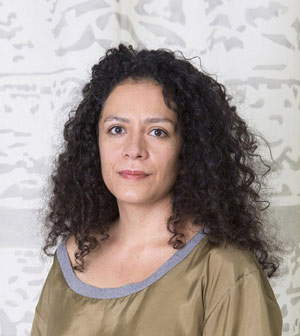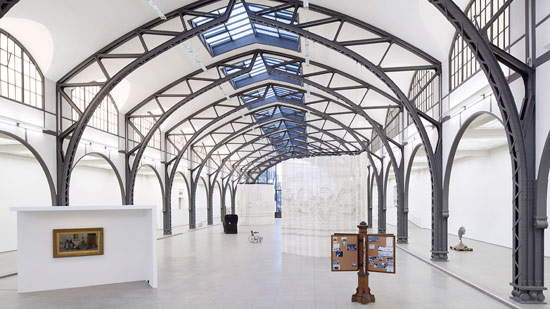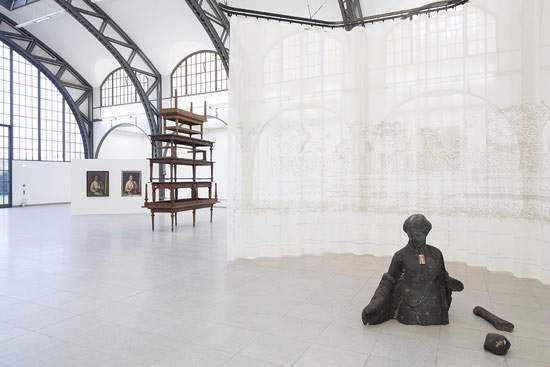Mexican artist Mariana Castillo Deball is exhibiting Parergon, her work, in the historicHamburger Bahnhof pavilion inBerlin until March 1, after winning the German National Gallery Prize in 2013 by presenting this project. In this interview with Descubrir el Arte, she explains what it is: an installation consisting of 25 parts, which has as its theme the historical, philosophical and artistic transformation of things.
 |
| Mariana Castillo Deball |
The National Gallery Prize was born in 2000, when collector Rolf Hoffmann proposed to support and promote the contemporary works of young talents within the Friends of the National Gallery Association. Since then, the prize has become one of the most important awards for new artists living or working in Germany. The prize consisted of the remarkable sum of 1,000 Deutschmarks, equivalent to 50,000 euros today.
Since 2002, the stakes have increased, adding to the prize the purchase of one of the winning artist’s works. In addition, other artistic disciplines, such as film, have been included in recent years; in fact, today the Art Prize is also awarded to the young film talent. In spite of this, in 2013, the reward underwent some changes: the cash prize was replaced by the opportunity for the winner to have his or her work exhibited in what is now the Berlin Museum of Contemporary Art. The museum also answers to the name Hamburger Bahnhof, since a train station was established in this space in the mid-19th century, which was later transformed into an exhibition space in the 1980s. Once again, the cultural event is realized in part thanks to the contribution of private companies such as BMW, whose cultural sector is responsible for sponsoring both the plastic arts and film awards.
 |
| Historical photo of the Hamburger Bahnohf in 1927 - © BPK |
 |
| The Hamburger Bahnohf in 1984 - © Stefan Koppelkamm |
 |
| The Berlin Museum of Contemporary Art |
Mariana Castillo, star of the seventh edition, adds this award to her long journey that began in 1997, after graduating in Fine Arts from the National Autonomous University of Mexico. Five years later, she received a master’s degree from the Jan van Eyck Academy in Maastricht. There then followed numerous individual exhibitions that left a trace of the artist all over the world. From The Wall and the books: 987 words stolen from a library at the Jan van Eyck Academy in Maastricht (2002) or Estas ruinas que ves at the Museo de Arte Carillo Gil in Mexico, D.F. (2006) to What we caught we threw away, What we didn´t catch we kept at the Center for Contemporary Art in Glasgow and Palabra e pedra solta ñao têm volta, which was held in São Paulo, Brazil in 2013. He has also participated in a long list of group exhibitions, such as this year’s at the Solomon R. Guggenheim Museum in New York’s Under the Same Sun: Art from Latin America Today.
Regarding the Parergon installation, the artist explains what the main idea behind the project, which was later exhibited at the museum, came from: I decided to use what the institution of the National Gallery offered, focusing on the history of the collections, the history of where the objects came from, and how the works exhibited here have been transformed over the years . All the objects I used have to do with Berlin, either because they arrived here from other parts of the world, or because they were exhibited here or because they were destroyed here or have a connection to the city.
On the other hand, the building that houses the museum is very important because of its past: since the period after World War II, it has maintained a very distinctive appearance. In fact, in the 1980s, when people were first able to enter this place, they had the feeling that time had stood still here, a feeling similar to that conveyed by the selected works.
The artist composed the installation using, among the tools, a burned-out train wheel or an exploded train interior part. This is because in a way they have become a sculpture or are simply objects that speak for themselves, as happens in all cases, since I looked for things in which a transformation, both historical and material, was perceived in the visible or tangible surface, with the intention of going beyond language. For this reason, the title of the installation is the Greek term for what is around the work, which can be the frame, the ornament or simply the commentary that is made about it.
This work shows very well my way of making art: very often the work comes out of itself and turns into something else. My work intersects with archaeology, with ethnology or history, although the discourse I create is neither linear nor a narrative story, but consists only of interrupted futures. It is an idea of a set of temporal detours.




Warning: the translation into English of the original Italian article was created using automatic tools. We undertake to review all articles, but we do not guarantee the total absence of inaccuracies in the translation due to the program. You can find the original by clicking on the ITA button. If you find any mistake,please contact us.